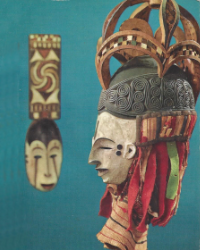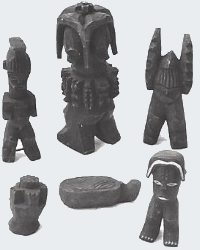Chapter 2
Field Notes and Stories
In Chapter One, I presented the photos of my collection and whatever information I had on each piece. It is not comprehensive. I was an enthusiastic amateur, not a trained anthropologist. I got as much information as time and situation allowed, which, I acknowledge, was unavoidably incomplete. I later learned that I had ventured into topics and areas of interest that few, if any, trained scholars had previously explored.
Here, in Chapter Two, I offer various field photographs and notes, including pictures of things I collected but did not take out of Nigeria, photos of things I found in my travels that I did not attempt to purchase, and pictures from other sources that help broaden the perspective. In many cases, my comments are more than just captions; they tell larger stories ranging from visits with carvers in the villages to stories about Peace Corps experiences. In some cases, I try to take you with me into the moment, into the setting. Many of my experiences were too good to keep to myself. Some may get a bit autobiographical, but they are part of the bigger picture.
I recognize today (2024 at the time of this writing), at age eighty-five, that many of the wonderful experiences in my life happened in Nigeria, in the Peace Corps. I'm happy to share some of them with you here.
If you wish to learn more in-depth about some of the things I touch on in the Gallery descriptions, I recommend you look into Cole's excellent books and Ottenberg for matters about Afikpo. In the References Section above I have also listed other scholars who have also done noteworthy works on Igboland.
In early 1966, near the end of my Peace Corps tour of duty, Herbert M. Cole (who we know as Skip) visited Enugu. I learned that he was there to do research on Igbo art for his PhD thesis. I invited him to join me on a trip to Inyi. I introduced him to Aka Gworo, one of my favorite carvers there. I believe this was Cole's first visit to the "bush," meeting a village carver. He went on, of course, to visit many other places that were significant to Igbo art. The information he collected over the years helped produce several significant and important works on Igbo art, all this in a thorough and academic way that was beyond me at the time. These notes also recall some of the other trips we took together.
Note: I must apologize for the poor focal quality of some of the pictures. I had a small and very inexpensive camera at the time. For many pictures in this section, I had to decide to omit them. For others, I felt the information contained was too valuable, blurred or not, to leave out, so they were included.
Sculptures
Traditional arts in Igboland take many forms... Perhaps the most epic in sculpture design are the shrine figures.
Go to Section
Masks
Igbo masking traditions vary—what is common and traditional in one section of Igboland is not necessarily found in another...
Go to Section
Divination Pieces
The smallest of carvings are the divination pieces used by diviners, in Igbo called dibia...
Go to Section
Pottery
Clay is not common in most Igbo communities. I found only two villages where significant pottery was made...
Go to Section